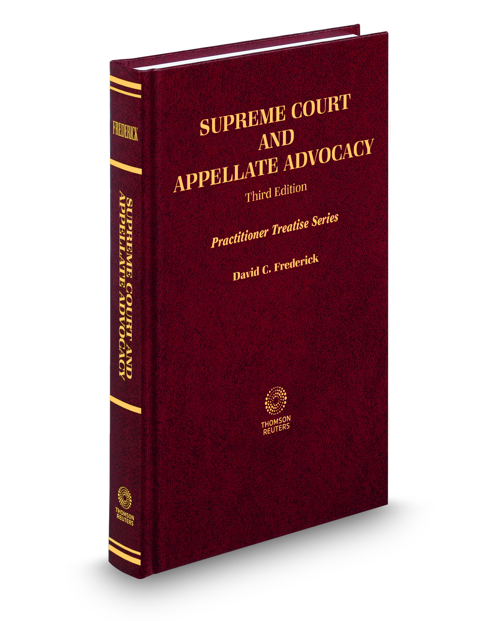A New Edition for a New Court: Supreme Court and Appellate Advocacy, Third Edition

What is needed to argue a case to the justices of the U.S. Supreme Court (and other appellate courts) has changed along with the changing jurists and the laws they interpret. Author David C. Frederick saw a need for addressing those changes, and the third edition of Supreme Court and Appellate Advocacy was created.
David C. Frederick, a partner in the firm of Kellogg, Hansen, Todd, Figel & Frederick, PLLC, has argued more than 100 appeals, including more than 50 before the U.S. Supreme Court, in every U.S. Court of Appeals and in five state supreme courts. Before the U.S. Supreme Court, Frederick has represented individuals, investors, immigrants, classes of consumers, farmers, Native Americans, small corporations, trade associations, large companies, foreign governments, individual states, the United States and the European Community. He has won landmark cases to protect consumer, worker and investor rights, and has become a leading advocate for states in a wide range of disputes.
In her foreword, Associate Justice Ruth Bader Ginsburg describes the value of this treatise to practitioners in oral argument before the Supreme Court and other appellate courts:
Frederick’s step-by-step analysis, his account of the components of oral argument, can arm an attorney to perform to best effect before any of our nation’s multi-judge courts. He knows that examples work more forcibly on the mind than precepts. His text is rich in illustrations showing how an advocate can rise or fall with the occasion. Constantly informative, the book is also laced with humor that eases the reader’s way.
Noted Supreme Court practitioner Theodore B. Olson lists Frederick and this book among the “oracles” he suggests consulting to make the most out of oral argument in the Winter 2018 issue of the American Bar Association’s Litigation magazine.
Frederick’s approach is to explain the principles of effective advocacy before the Supreme Court and appellate courts, drawn from the collective experience of members of the Solicitor General’s Office and the finest practitioners who have appeared before them. Even those who never set foot behind the lectern in the Supreme Court or a court of appeals may gain a better understanding of how those courts work as institutions and how attorneys may improve as advocates in any forum in which they appear.
In this third edition, the author builds on new insights gleaned from his continuing practice as a Supreme Court and appellate litigator. One of the new sections of this book concerns learning styles, the concept that each person learns and masters new materials in somewhat different ways. Another new section charts the rise of female advocates in the Supreme Court Bar, a development that began in the mid-20th century and has blossomed in the first decades of this century. The chapter on questions has been reorganized to develop more comprehensively the reasons why justices and judges ask questions at oral argument.
More generally, the book seeks to update and refine examples from actual arguments, as well as explain newer rules that the Supreme Court and U.S. Courts of Appeals have adopted. Throughout, Frederick has added new insights about particular aspects of oral argument, from fashioning openings in different circumstances to handling closing, as well as techniques for managing rebuttal on the fly. The discussion of notes and argument binders also contains updated views about being better organized in the courtroom to maximize precious time. Although many older examples remain in this edition, new examples are sprinkled throughout, and new insights and experiences are described.
For more information on the content and to buy the third edition of Supreme Court and Appellate Advocacy, click here.
This post was written by Greg Bell, a principal attorney editor for Thomson Reuters.